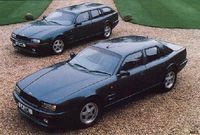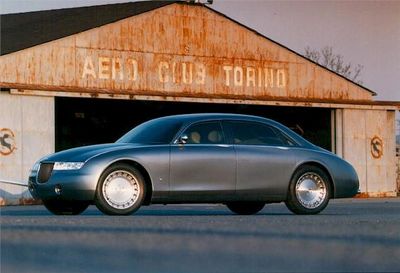.
Lagonda
Search By Model |
| On Hiatus |
Lagonda was a British car manufacturer, founded in 1906 in Staines, Middlesex by the American Wilbur Gunn. He named the company after a river near his home town of Springfield, Ohio. The company was purchased and integrated into Aston Martin in 1947.
History
Wilbur Gunn had originally built motorcycles on a small scale with reasonable success including a win on the 1905 London—Edinburgh trial. In 1907 he launched his first car, the 20 hp 6 cylinder Torpedo, which he used to win the Moscow—St. Petersburg trial of 1910. This success produced a healthy order for exports to Russia which continued until 1914. In the pre war period Lagonda also made an advanced small car, the 11.1 with a four cylinder 1000 cc engine, which featured an anti-roll bar and a rivetted monocoque body and the first ever fly-off handbrake.
After the end of the war the 11.1 continued with a larger 1400 cc engine and standard electric lighting as the 11.9 until 1923 and the updated 12 until 1926. The first of the company's sports models was launched in 1925 as the 14/60 with a twin cam 1954 cc 4 cylinder engine and hemispherical combustion chambers. The car was designed by Arthur Davidson who had come from Lea-Francis. A higher output engine came in 1927 with the 2 litre Speed Model which could be had supercharged in 1930. A lengthened chassis version, the 16/65, with 6 cylinder 2.4 litre engine, was available from 1926 to 1930. The final car of the 1920's was the 3 litre using a 2931 cc 6 cylinder engine. This continued until 1933 when the engine grew to 3181 cc and was also available with a complex 8 speed Maybach transmission as the Selector Special.
A new model for 1933 was the 16-80 using a 2 litre Crossley engine with pre-selector gearbox from 1934. A new small car, the Rapier came along in 1934 with 1087 cc engine and pre-selector gearbox. This lasted until 1935 but more were made until 1938 by a separate company, Rapier Cars of Hammersmith, London. At the other extreme was the near 100 mph, 4.5 litre M45 with Meadows 6 cylinder 4467 cc engine. An out and out sporting version the M45R Rapide, with tuned M45 engine and a shorter chassis led to a Le Mans victory in 1935. Also in 1935 the 3 litre grew to a 3.5 litre.
All was not well financially and the receiver was called in in 1935 but the company was bought by Alan Good, who just outbid Rolls-Royce. He also persuaded W. O. Bentley to leave Rolls-Royce and join Lagonda as designer. The 4.5 litre range now became the LG45 with lower but heavier bodies and also available in LG45R Rapide form. The LG45 came in 3 versions known as Sanction 1,2 and 3 each with more Bentley touches to the engine. In 1938 the LG6 with independent front suspension by torsion bar and hydraulic brakes came in.
Bentley's masterpiece the V12 was launched in 1937. The 4480 cc engine delivered 180bhp and was said to be capable of going from 7 to 105 mph in top gear and to rev to 5000 rpm.
Aston Martin
In 1947 the company was taken over by David Brown and the company moved in with Aston Martin, which he had also bought, in Feltham, Middlesex. Production restarted with the last model from W. O. Bentley, the 1948 2.6-Litre with new chassis featuring fully independent supension. Its new 2580 cc twin overhead cam straight 6 became the basis for the Aston Martin engines of the 1950s. The engine grew to 3 litres in 1953 and continued to be available until 1958.
Many thought that the marque had disappeared but in 1961 the Rapide name was resurrected with aluminium body by Carrozzeria Touring of Milan and 3995 cc engine capable of taking the car to 125 mph. By this time, Aston Martin-Lagonda as it now was, had moved to Newport Pagnell in Buckinghamshire. The Rapide lasted until 1965.
Between 1974 and 1976, seven Lagonda saloons were produced on the basis of the Aston Martin V8.
One more car was to appear with the large and futuristic Aston Martin Lagonda of 1976 designed by William Towns. This low, rather square, wedge shaped car was built on Aston Martin V8 components and was available, at least in theory, until 1989.
Aston Martin produced a concept car called the Lagonda Vignale at the 1993 Geneva motor show.
In 1994, a handful of Lagonda 4-door saloons and shooting brakes were built on the basis of the Aston Martin Virage. Although these are the most recent cars to wear a Lagonda badge, the Rapide name is expected to be revived for 2009 as the Aston Martin Rapide saloon.
Future models
Aston Martin said on 1st September 2008, as reported by Automotive News Europe that it will relaunch its Lagonda brand to help it expand into new markets and partly to celebrate Lagonda's Centennial Anniversary in 2009.
"The Lagonda brand would allow us to develop cars which can have a different character than a sports car," said CEO Ulrich Bez in a statement. "Lagonda will have its own niche with luxurious and truly versatile products suitable for both existing and emerging markets".
"Lagonda models would be vehicles that could be used all year round in markets such as Russia where specialized sports cars such as Aston Martins could only be used for three or four months each year", said spokeswoman Janette.
Discontinued models
| Year | Type | Engine | Production |
|---|---|---|---|
| 1906-1913 | 20 | 3052 cc side valve 4 cylinder | |
| 1911-1913 | 30 | 4578 cc side valve 4 cylinder | |
| 1913-1921 | 11 | 1099 cc inlet over exhaust valve 4 cylinder | 6000(inc 11.9 and 12) |
| 1920-1923 | 11.9 | 1421 cc inlet over exhaust valve 4 cylinder | 6000(inc 11 and 12) |
| 1923-1926 | 12 and 12/24 | 1421 cc inlet over exhaust valve 4 cylinder | 6000 (inc 11 and 11.9) |
| 1925-1933 | 14/60 and 2 litre Speed | 1954 cc ohv 4 cylinder | 1440 |
| 1926-1930 | 16/65 | 2389 (later 2692) cc ohv 6 cylinder | 250 |
| 1928-1934 | 3 litre | 2931 cc ohv 6 cylinder | 570 |
| 1926-1930 | 16/80 | 1991 cc ohv 6 cylinder Crossley | 260 |
| 1933-1938 | Rapier | 1087 cc twin ohc 4 cylinder | 470 + app 45 by Rapier Cars |
| 1926-1930 | M45 | 4467 cc ohv 6 cylinder Meadows | 410 + 53 M45R Rapide |
| 1935 | 3.5 litre | 3619 cc ohv 6 cylinder | 65 |
| 1936-1937 | LG45 | 4467 cc ohv 6 cylinder Meadows | 278 + 25 Rapides |
| 1938-1940 | LG6 | 4467 cc ohv 6 cylinder Meadows | 85s |
| 1938-1940 | V12 | 4480 cc double overhead cam V12 | 189 |
| 1948-1953 | 2.6-Litre | 2580 cc double ohc 6 cylinder | 510 |
| 1953-1958 | 3-Litre | 2922 cc double ohc 6 cylinder | 270 |
| 1961-1965 | Rapide | 3995 cc double ohc 6 cylinder | 55 |
| 1976-1989 | Aston Martin Lagonda | 5340 cc ohc V8 |
Photos
See also
| image (between 170-190 pixels) | ||
| LAGONDA | ||
|
Prodrive | Aston Martin | Lagonda | Tickford | Glenn Seton Racing | Aston Martin Racing Models Rapide · Rapier · 3-Litre · 2.6-Litre Concept | ||
| Wilbur Gunn | Include the marque's Corporate website here and indicate as such. | A brand of Prodrive Ltd. and Aston Martin |
External links
- Based in the UK, the club's aims are to preserve and develop the interest in and traditions of all types of Lagonda vehicles. It has members from across the world.
- Roger Ivett's site dedicated to the Aston Martin Lagonda
- Lagonda Rapier Enthusiasts Web Site
- Aston Martin Revives ‘Lagonda’ Brand, first Concept Car due in 2009
- Aston Martin officially revives Lagonda marque
- Aston Martin Lagonda line could have SUV flavor
- Aston Martin's Lagonda S-class fighter coming in 2012



